Top speed 1,145 km/h Length 11 m Cruise speed 861 km/h | Introduced October 1952 Range 821 km Wingspan 9.63 m | |
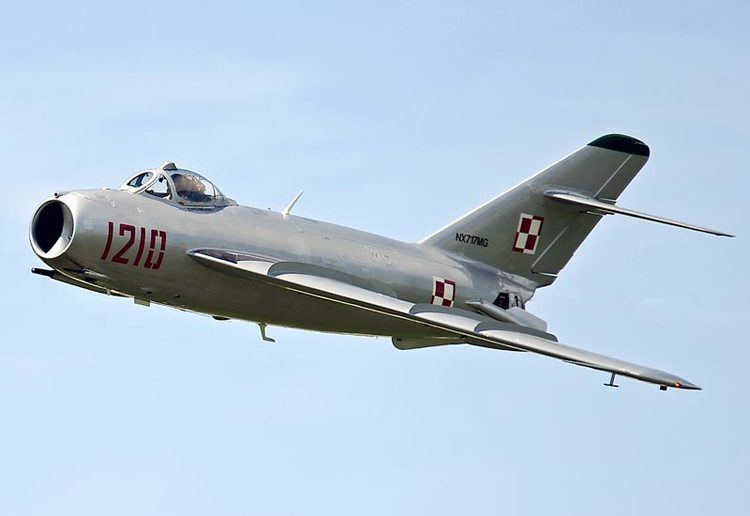 | ||
2011 gathering of eagles xv air show mikoyan gurevich mig 17 fresco sunday flight
The Mikoyan-Gurevich MiG-17 (Russian: Микоян и Гуревич МиГ-17) (NATO reporting name: Fresco) (China:Shenyang J-5) (Poland: PZL-Mielec Lim-5) is a high-subsonic fighter aircraft produced in the USSR from 1952 and operated by numerous air forces in many variants. It is an advanced development of the very similar appearing MiG-15 of the Korean War.
Contents
- 2011 gathering of eagles xv air show mikoyan gurevich mig 17 fresco sunday flight
- Black diamond jet team mikoyan gurevich mig 17 pair
- Development
- License production
- Operational history
- Vietnam War
- MiG 17J 5 aerial combat victories in the Vietnam War 1965 1972
- Other MiG 17 users
- Africa
- Asia
- Soviet Union
- United States
- Variants
- Current operators
- Former operators
- Specifications MiG 17F
- References

MiG-17s first saw combat in 1958 in the Taiwan Strait Crisis and later proved to be an effective threat against more modern supersonic fighters of the United States in the Vietnam War. It was also briefly known as the Type 38, by U.S. Air Force designation prior to the development of NATO codes.
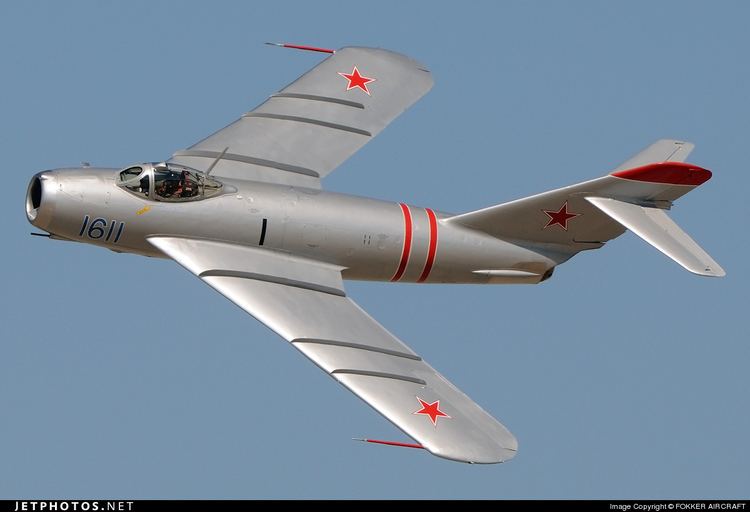
Black diamond jet team mikoyan gurevich mig 17 pair
Development
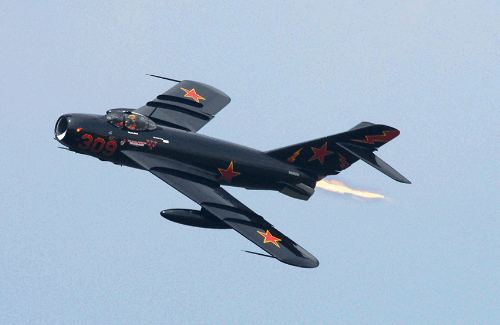
While the MiG-15bis introduced swept wings to air combat over Korea, the Mikoyan-Gurevich design bureau had already begun work on its replacement in 1949 (originally the MiG-15bis45) in order to fix any problems found with the MiG-15 in combat. The result was one of the most successful transonic fighters introduced before the advent of true supersonic types such as the Mikoyan-Gurevich MiG-19 and North American F-100 Super Sabre. The design would ultimately still prove effective into the 1960s when pressed into subsonic dogfights over Vietnam against much faster planes which were not optimized for maneuvering in such slower speed, short-range engagements.
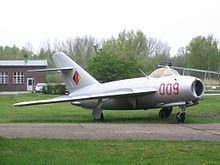
While the MiG-15 used a Mach sensor to deploy airbrakes because it could not safely exceed Mach 0.92, the MiG-17 was designed to be controllable at higher Mach numbers. Early versions which retained the original Soviet copy of the Rolls-Royce Nene VK-1 engine were heavier with equal thrust. Later MiG-17s would be the first Soviet fighter application of an afterburner which offered increased thrust on demand by dumping fuel in the exhaust of the basic engine.
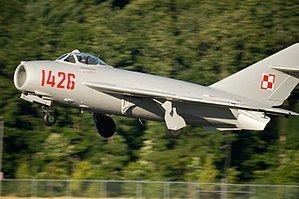
Though the MiG-17 still strongly resembles its forebear, it had an entirely new thinner and more highly swept wing and tailplane for speeds approaching Mach 1. While the F-86 introduced the "all-flying" tailplane which helped controllability near the speed of sound, this would not be adopted on MiGs until the fully supersonic MiG-19. The wing had a "sickle sweep" compound shape with a 45° angle like the U.S. F-100 Super Sabre near the fuselage (and tailplane), and a 42° angle for the outboard part of the wings. The stiffer wing resisted the tendency to bend its wingtips and lose aerodynamic symmetry unexpectedly at high speeds and wing loads. Like its forebearer, the MiG-17 inherited a major design deficit which caused its fuel tanks to develop an under-pressure condition if more than half the fuel had been used which could lead to tank implosions, crushing the main fuselage of the aircraft in mid-flight with almost always fatal results. Roughly 30% of the fatal accidents of Soviet MiG-17 were attributed to this problem.
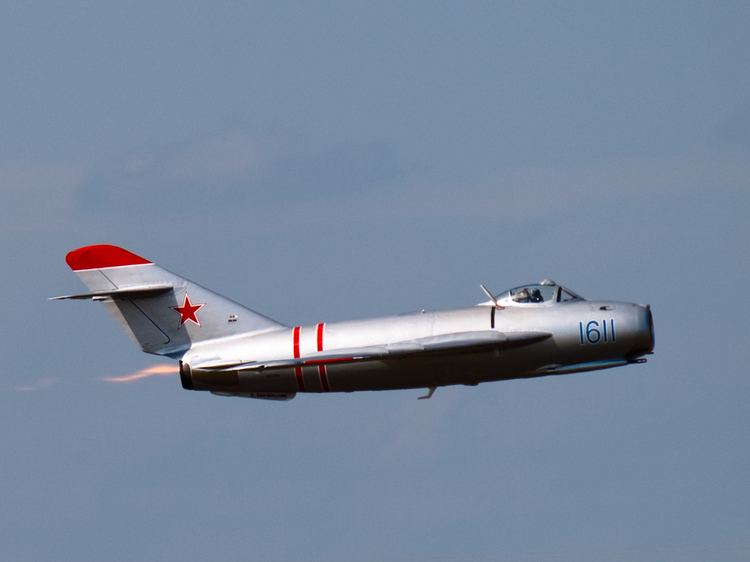
Other easily visible differences to its predecessor were the addition of a third wing fence on each wing, the addition of a ventral fin and a longer and less tapered rear fuselage that added about one meter in length. The MiG-17 shared the same Klimov VK-1 engine, and much of the rest of its construction such as the forward fuselage, landing gear and gun installation was carried over. The first prototype, designated I-330 "SI" by the construction bureau, was flown on the 14 January 1950, piloted by Ivan Ivashchenko.
In the midst of testing, pilot Ivan Ivashchenko was killed when his aircraft developed flutter which tore off his horizontal tail, causing a spin and crash on 17 March 1950. Lack of wing stiffness also resulted in aileron reversal which was discovered and fixed. Construction and tests of additional prototypes "SI-2" and experimental series aircraft "SI-02" and "SI-01" in 1951, were generally successful. On 1 September 1951, the aircraft was accepted for production, and formally given its own MiG-17 designation after so many changes from the original MiG-15. It was estimated that with the same engine as the MiG-15's, the MiG-17's maximum speed is higher by 40–50 km/h, and the fighter has greater manoeuvrability at high altitude.
Serial production started in August 1951, but large quantity production was delayed in favor of producing more MiG-15s so it was never introduced in the Korean War. It did not enter service until October 1952, when the MiG-19 was almost ready to be flight tested. During production, the aircraft was improved and modified several times. The basic MiG-17 was a general-purpose day fighter, armed with three cannons, one Nudelman N-37 37mm cannon and two 23mm with 80 rounds per gun, 160 rounds total. It could also act as a fighter-bomber, but its bombload was considered light relative to other aircraft of the time, and it usually carried additional fuel tanks instead of bombs.
Although a canopy which provided clear vision to the rear necessary for dogfighting like the F-86 was designed, production MiG-17Fs got a cheaper rear-view periscope which would still appear on Soviet fighters as late as the MiG-23. By 1953, pilots got safer ejection seats with protective face curtain and leg restraints like the Martin-Baker seats in the west. The MiG-15 had suffered for its lack of a radar gunsight, but in 1951, Soviet engineers obtained a captured F-86 Sabre from Korea and they copied the optical gunsight and SRD-3 gun ranging radar to produce the ASP-4N gunsight and SRC-3 radar. The combination would prove deadly over the skies of Vietnam against aircraft such as the F-4 Phantom whose pilots lamented that guns and radar gunsights had been omitted as obsolescent.
The second prototype variant, "SP-2" (dubbed "Fresco A" by NATO), was an interceptor equipped with a radar. Soon a number of MiG-17P ("Fresco B") all-weather fighters were produced with the Izumrud radar and front air intake modifications.
In early 1953 the MiG-17F day fighter entered production. The "F" indicated it was fitted with the VK-1F engine with an afterburner by modifying the rear fuselage with a new convergent-divergent nozzle and fuel system. The afterburner doubled the rate of climb and greatly improved vertical maneuvers. But while the plane was not designed to be supersonic, skilled pilots could just dash to supersonic speed in a shallow dive, although the aircraft would often pitch up just short of Mach 1. This became the most popular variant of the MiG-17. The next mass-produced variant, MiG-17PF ("Fresco D") incorporated a more powerful Izumrud RP-2 radar, though they were still dependent on Ground Control Interception to find and be directed to targets. In 1956 a small series (47 aircraft) was converted to the MiG-17PM standard (also known as PFU) with four first-generation Kaliningrad K-5 (NATO reporting name AA-1 'Alkali') air-to-air missiles. A small series of MiG-17R reconnaissance aircraft were built with VK-1F engine (after first being tested with the VK-5F engine).
Almost 8,000 MiG-17s were built in the USSR by 1958. Over 3,000 were built under licence in Poland, Czechoslovakia and China.
License production
In 1955, Poland received a license for MiG-17 production. The MiG-17F was produced by the WSK-Mielec factory under the designation Lim-5 (an abbreviation of licencyjny myśliwiec - licence-built fighter). The first Lim-5 was built on 28 November 1956 and 477 were built by 1960. Apart from Poland, a number were exported to Bulgaria, designated as MiG-17F. An unknown number were built as the Lim-5R reconnaissance variant, fitted with the AFA-39 camera. In 1959–1960, 129 MiG-17PF interceptors were produced as the Lim-5P. WSK-Mielec also developed several Polish strike variants based on the MiG-17: the Lim-5M, produced from 1960; Lim-6bis, produced from 1963; and Lim-6M (converted in the 1970s); as well as two reconnaissance variants: the Lim-6R (Lim-6 "bis" R) and MR.
In the People's Republic of China (PRC), an initial MiG-17F was assembled from parts in 1956, with license production following in 1957 at Shenyang. The Chinese-built version is known as the Shenyang J-5 (for local use) or F-5 (for export).
Operational history
MiG-17s were designed to intercept straight-and-level-flying enemy bombers, not for air-to-air combat (dogfighting) with other fighters. This subsonic (.93 Mach) fighter was effective against slower (.6-.8 Mach), heavily loaded U.S. fighter-bombers, as well as the mainstay American strategic bombers during the MiG-17's development cycle (such as the Boeing B-50 Superfortress or Convair B-36 Peacemaker, which were both still powered by piston engines). It was not however able to intercept the new generation of British jet bombers such as the Avro Vulcan and Handley Page Victor, which could both fly higher. Even if the target had sufficient warning and time to shed weight and drag by dropping external ordnance and accelerate to supersonic escape speeds, doing so would have inherently forced the enemy aircraft to abort its bombing mission. However, the USAF's introduction of strategic bombers capable of supersonic dash speeds such as the Convair B-58 Hustler and General Dynamics FB-111 rendered the MiG-17 obsolete in front-line PVO service, and they were supplanted by supersonic interceptors such as the MiG-21 and MiG-23.
MiG-17s were not available for the Korean War, but saw combat for the first time over the Straits of Taiwan when the Communist PRC MiG-17s clashed with the Republic of China (ROC, Nationalist China) F-86 Sabres in 1958.
In 1958, MiG-17s downed a US reconnaissance Lockheed C-130 Hercules over Armenia, with 17 casualties.
Vietnam War
In 1960, the first group of approximately 50 North Vietnamese airmen were transferred to the PRC to begin transitional training onto the MiG-17. By this time the first detachment of Chinese trained MiG-15 pilots had returned to North Vietnam, and a group of 31 airmen were deployed to the North Vietnamese Air Force base at Son Dong for conversion to the MiG-17. By 1962 the first North Vietnamese pilots had finished their MiG-17 courses in the Soviet Union and the PRC, and returned to their units; to mark the occasion, the Soviets sent as a "gift" 36 MiG-17 fighters and MiG-15UTI trainers to Hanoi in February 1964. These airmen would create North Vietnam's first jet fighter regiment, the 921st. By 1965, another group of MiG pilots had returned from training in Krasnodar, in the USSR, as well as from the PRC. This group would form North Vietnam's second fighter unit, the 923rd Fighter Regiment. While the newly created 923rd FR operated only MiG-17s, and initially these were the only types available to oppose modern American supersonic jets before MiG-21s and MiG-19s were introduced into North Vietnamese service (the 925 FR reginment was formed in 1969, flying MiG-19s).
American fighter-bombers had been in theatre flying combat sorties since 1961, and the U.S. had many experienced pilots from the Korean War and World War II, such as World War II veteran Robin Olds. Untried MiGs and pilots of the North Vietnamese Air Force would be pitted against some of the most combat experienced airmen of the U.S. Air Force (USAF) and U.S. Navy. On 3 April 1965 six MiGs took off from Noi Bai airbase in two groups of two and four respectively, with the first acting as bait and the second being the shooters. Their target were U.S. Navy aircraft supporting an USAF 80-aircraft strike package trying to knock out Ham Rung bridge near Thanh Hoa. The MiG-17 leader, Lt. Pham Ngoc Lan, attacked a group of Vought F-8 Crusaders of VF-211 from USS Hancock and damaged an F-8E flown by Lt. Cdr. Spence Thomas, who managed to land the aircraft at Da Nang airbase. A second F-8 was claimed by his wingman Phan Van Tuc but this is not corroborated by USN loss listings.
On 4 April 1965, the USAF made another attempt on the Hàm Rồng/Thanh Hoa bridge with 48 Republic F-105 Thunderchiefs of the 355th Tactical Fighter Wing (TFW) loaded with 384 x 750 lb (340 kg) bombs. The Thunderchiefs were escorted by a MIGCAP flight of North American F-100 Super Sabres from the 416th Tactical Fighter Squadron (TFS). Coming from above, four MiG-17s from the 921st Fighter Regiment (FR) bypassed the escorts and dove onto the Thunderchiefs, shooting two of them down; the leader Tran Hanh downed F-105D BuNo. 59-1754 of Major F. E. Benett, and his element leader Le Minh Huan downed F-105D BuNo. 59-1764 of Captain J. A. Magnusson. The Super Sabres engaged; one AIM-9 Sidewinder air-to-air missile was fired and missed (or malfunctioned), and another F-100D flown by Captain Donald Kilgus fired 20mm cannons, scoring a probable kill. Tran Hanh's wingman Pham Giay Went down and was killed. No other U.S. airmen reported any confirmed aerial kills during the air battle; Tran Hanh stated that three of his accompanying MiG-17s had been shot down by the opposing USAF fighters.
Three F-100s from the MiGCAP, piloted by LTC Emmett L. Hays, CPT Keith B. Connolly, and CPT Donald W. Kilgus, all from the 416th TFS, The four attacking MiGs from the 921st FR were flown by Flight Leader Tran Hanh, Wingman Pham Giay, Le Minh Huan and Tran Nguyen Nam. Flight Leader Tran Hanh was the only Vietnamese survivor from the air battle and believed that the others in his flight were "... shot down by the F-105s." Based upon the report, the USAF F-100s could have been mistaken for F-105s, and the loss of three MiG-17s was attributed to Super Sabres, the first aerial victories of any American aircraft in the war. The F-100s themselves would never again encounter MiGs, being relegated to close air support. They were replaced in the MiGCAP role by faster and longer range but less manoeuvrable McDonnell Douglas F-4 Phantoms.
The MiG-17 was the primary interceptor of the fledgling Vietnam People's Air Force in 1965, responsible for their first aerial victories and seeing extensive service during the Vietnam War. Some North Vietnamese pilots preferred the MiG-17 over the MiG-21 because it was more agile, though not as fast; 3 of the 16 NVAF Aces of the war (credited with shooting down five or more opposing aircraft) were from MiG-17s. Those were: Nguyen Van Bay (7 victories), Luu Huy Chao and Le Hai (both with six). The rest gained ace status in MiG-21s.
MiG-17/J-5 aerial combat victories in the Vietnam War 1965-1972
This table lists North Vietnamese Air Force (NVAF) and Chinese Communist (Chicom) air-space violation air-to-air kills. Sources include Hobson p. 271, and Toperczer (#25) p. 88-90.
The MiG-17 was not originally designed to function as a fighter-bomber, but in 1971 Hanoi directed that United States Navy warships were to be attacked by elements of the North Vietnamese Air Force. This would require the MiG-17 to be fitted with bomb mountings and release mechanisms. Chief Engineer of the NVAF ground crews, Truong Khanh Chau, was tasked with the mission of modifying two MiG-17s for the ground attack role; after three months of work, the two jets were ready. On 19 April 1972, two pilots from the 923rd FR took their bomb laden MiG-17s and attacked the U.S. Navy destroyer USS Higbee (DD-806) and light cruiser USS Oklahoma City (CLG-5). Each MiG was armed with two 250 kg (550 lb) bombs. Pilot Le Xuan Di managed to hit the destroyer's aft 5" gun mount, destroying it, but inflicting no fatalities, as the crewmen had vacated the turret earlier due to a malfunction with the gun system. After the war, Truong Khanh Chau became the Director of the Vietnam Institute for Science and Technology in 1977.
From 1965 to 1972, MiG-17s from the NVAF 921st and 923rd FRs would claim 71 aerial victories against U.S. aircraft: 11 Crusaders, 16 F-105 Thunderchiefs, 32 McDonnell Douglas F-4 Phantom IIs, two Douglas A-4 Skyhawks, seven Douglas A-1 Skyraiders (propeller driven strike aircraft), one C-47 cargo/transport aircraft, one Sikorsky CH-3C helicopter and one Ryan Firebee UAV.
The American fighter community was shocked in 1965 when elderly, subsonic MiG-17s downed sophisticated Mach-2-class F-105 Thunderchief fighter-bombers over North Vietnam. As a result of these experiences the U.S. Air Force initiated project "Feather Duster" aimed at developing tactics that would enable the heavier American fighters to deal with smaller and more agile opponents like the MiG-17. To simulate the MiG-17 the U.S. Air Force chose the North American F-86H. One pilot who participated in the project remarked that "In any envelope except nose down and full throttle", either the F-100 or F-105 was inferior to the F-86H in a dogfight. The project was generally successful in that the resulting tactics effectively minimised the disadvantages of the F-105, F-100 and other heavy American fighters while minimising the advantages of slower but more manoeuvrable fighters such as the F-86 and the MiG-17.
Other MiG-17 users
Twenty countries flew MiG-17s. The MiG-17 became a standard fighter in all Warsaw Pact countries in the late 1950s and early 1960s. They were also bought by many other countries, mainly in Africa and Asia, that were neutrally aligned or allied with the USSR. The MiG-17 still flies today in the air forces of Democratic Republic of the Congo, Guinea, Mali, Madagascar, Sudan, and Tanzania, and by extension through the Shenyang J-5, North Korea. JJ-5s trainers still in limited use in China as well.
Africa
At least 24 of them served with the Nigerian Air Force and were flown by a mixed group of Nigerian and mercenary pilots from East Germany, Soviet Union, South Africa, the United Kingdom, and Australia during the 1967–70 Nigerian Civil War.
Asia
Four were hurriedly supplied by the USSR to Sri Lanka during the 1971 insurgency and were used for bombing and ground attack in the brief insurgency. Four North Korean MiG-17 aircraft were involved in the EC-121 shootdown incident in 1969.
Soviet Union
Similarly in 1958, a U.S. Air Force Lockheed C-130 was shot down by four MiG-17 fighters when it flew into Soviet airspace near Yerevan, Armenia while on a Sun Valley Signal intelligence mission, with all 17 crew killed.
United States
A number of U.S. federal agencies undertook a program at Groom Lake to evaluate the MiG-17 to help fight the Vietnam War, as the kill ratio against North Vietnamese MiG-17s and MiG-21s was only 2:1. The program was code-named HAVE DRILL, involving trials of two ex-Syrian MiG-17F Frescos, acquired and provided by Israel, over the skies of Groom Lake. These aircraft were given USAF designations and fake serial numbers so that they may be identified in DOD standard flight logs.
In addition to tracking the dog fights staged between the various MiG models against virtually every fighter in U.S. service, and against SAC's B-52 Stratofortress and B-58 Hustlers to test the ability of the bombers’ countermeasures systems. They also performed radar cross-section and propulsion tests that contributed greatly to improvements in U.S. aerial performance in Vietnam.
According to the Federal Aviation Administration there are 27 privately owned MiG-17s in the U.S. Several Mig-17s have been seized due to questions over the legal nature of how they entered the country.
Variants
Some withdrawn aircraft were converted to remotely controlled targets.
Current operators
Former operators
Specifications (MiG-17F)
Blueprints:
Data from Combat Aircraft since 1945, MiG: Fifty Years of Secret Aircraft Design
General characteristics
Performance
Armament
